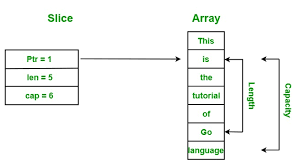面试的时候问到了一个关于 go Slice 的问题,即为什么在 a[i:] 中 i 的取值可以是 a 的长度。平时开发中也是这么用的,但没太深入的了解,所以在这篇文章中对其进行一些探讨。
slice 删除元素
Go 标准内置包没有提供太多操作 slice 的方法,所以如果要删除 slice 的元素通常都能找到以下的实现。
func remove(slice []int, s int) []int {
return append(slice[:s], slice[s+1:]...)
}
这里就引发出一个疑问:当要删除最后一个元素时,s+1 不就等于 slice 的长度了,但程序为什么没有报 index out of range 错误。
两种表达式的官方解释
官方对于 a[i] 和 a[low:high]有不同的定义,分别为索引表达式 和 slice 表示式,所以两者并非一个东西。
a[i] 表达式
下标的取值范围在 $0 \le i \lt len(a)$,如果超出了会报
out of range运行时错误。
a[low:high] 表示式
对于数组或字符串,下标的取值范围在 $0 \le low \le high \le len(a)$,即下标可以取到数组的长度或字符串的长度。对于 slice 来说,下标的取值上限是 slice 的容量,显然 slice 的容量会大于等于其长度。
package main
import (
"fmt"
)
func main() {
ints := make([]int, 0)
for i := 0; i < 3; i++ {
ints = append(ints, i)
}
fmt.Printf("length: %d, capacity: %d\n", len(ints), cap(ints))
fmt.Println(ints[3:4])
}
length: 3, capacity: 4
[0]
ints 的容量为 4,所以 ints[3:4] 符合定义。另外,扩容操作只有在使用 append 方法后才会执行,正常初始化的 slice 的长度与容量相同,如下:
package main
import "fmt"
func main() {
ints := []int{1, 2, 3}
fmt.Printf("length: %d, capacity: %d\n", len(ints), cap(ints))
}
length: 3, capacity: 3
值得注意的是,如果 a[low:high] 中的 high 缺省了会默认为 a 的长度,则 a[len(a):] 会变成 a[len(a):len(a)] ,而 len(a) - len(a) = 0,所以会取到一个空 [] 的 slice。
猜想一
猜想:a[len(a):] 是不是读到了 slice 相邻内存上的数据,因为相邻内存上没有数据,所以才会返回 []。所以要先了解下 slice 容量的扩展方式,例子如下:
package main
import (
"fmt"
)
func main() {
ints := make([]int, 0)
for i := 0; i < 9; i++ {
// sh := (*reflect.SliceHeader)(unsafe.Pointer(&ints))
fmt.Printf("before adding a element [%d]\n", i)
fmt.Printf("length: %d, capacity: %d\n", len(ints), cap(ints))
ints = append(ints, i)
fmt.Printf("after adding a element [%d]\n", i)
fmt.Printf("length: %d, capacity: %d\n", len(ints), cap(ints))
fmt.Println()
// slice 容量从 4 开始以 2 的倍数增加
}
}
before adding a element [0]
length: 0, capacity: 0
after adding a element [0]
length: 1, capacity: 1
before adding a element [1]
length: 1, capacity: 1
after adding a element [1]
length: 2, capacity: 2
before adding a element [2]
length: 2, capacity: 2
after adding a element [2]
length: 3, capacity: 4
before adding a element [3]
length: 3, capacity: 4
after adding a element [3]
length: 4, capacity: 4
before adding a element [4]
length: 4, capacity: 4
after adding a element [4]
length: 5, capacity: 8
before adding a element [5]
length: 5, capacity: 8
after adding a element [5]
length: 6, capacity: 8
before adding a element [6]
length: 6, capacity: 8
after adding a element [6]
length: 7, capacity: 8
before adding a element [7]
length: 7, capacity: 8
after adding a element [7]
length: 8, capacity: 8
before adding a element [8]
length: 8, capacity: 8
after adding a element [8]
length: 9, capacity: 16
从输出可以得知:
- 添加
int0 后,长度为 1,容量为 1; - 添加
int1 后,长度为 2,容量为 2; - 添加
int2 后,长度为 3,容量为 4; - 添加
int4 后,长度为 5,容量为 8; - 添加
int8 后,长度为 9,容量为 16;
综上,slice 底层数组的扩展规则为容量以 2 的倍数增长。
package main
import (
"fmt"
"reflect"
"unsafe"
)
func main() {
ints := make([]int, 0)
ints = append(ints, 1, 2, 3)
// slice 的长度为 3,容量为 3,取下标 3 的元素会越界
// fmt.Println("try to get the 4th element", ints[3])
// 取 slice 从下标 3 之后的元素,返回的是个 []
fmt.Println("try to get the rest elements from the 4th element: ", ints[3:])
// sh := (*reflect.SliceHeader)(unsafe.Pointer(&ints))
// 打印 ints 的起始地址
fmt.Printf("the start address of ints: %p\n", ints)
// 第一次:打印 ints[3:] 的起始地址
fmt.Printf("first the start address of ints[3:]: %p\n", ints[3:])
// 第二次:打印 ints[3:] 的起始地址
fmt.Printf("second the start address of ints[3:]: %p\n", ints[3:])
// 打印 ints[2] 的地址
fmt.Printf("the address of ints[2]: %p\n", &(ints[2]))
fmt.Println()
rest := ints[3:]
sh := (*reflect.SliceHeader)(unsafe.Pointer(&rest))
fmt.Printf("length: %d, capacity: %d\n", sh.Len, sh.Cap)
}
try to get the rest elements from the 4th element: []
the start address of ints: 0xc0000be090
first the start address of ints[3:]: 0xc0000be090
second the start address of ints[3:]: 0xc0000be090
the address of ints[2]: 0xc0000be0a0
ints 初始化为长度为 3、容量为 4 的 slice,对其进行取值操作,得到:
ints[3:]返回一个空的 slice[],同时其起始地址与ints起始地址相同;- 多次调用
ints[3:]始终返回相同的结果,且长度和容量均为 0;
显然,ints[3:] 并非取到了 ints 相邻内存中的值,所以猜想不成立。
猜想二
猜想:当 len(a) < cap(a) 时,a[i:j] (i <= j, len(a) < j) 取到了已分配内存中的零值。
package main
import (
"fmt"
)
func main() {
ints := make([]int, 0)
for i := 0; i < 5; i++ {
ints = append(ints, i)
}
fmt.Printf("length: %d, capacity: %d\n", len(ints), cap(ints))
fmt.Println(ints[4:8])
}
length: 5, capacity: 8
[4 0 0 0]
在上述代码中,ints 的长度为 5、容量为 8,ints[4:8] 中的下标值 8 符合小于等于容量的规定,语法有效。同时看到输出,也确实取到了已分配(未使用)内存中的值。

评论